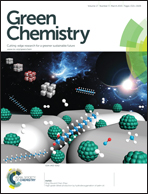Structural elucidation of whole lignin from Eucalyptus based on preswelling and enzymatic hydrolysis†
Abstract
The structural elucidation of whole lignin in the plant cell wall is extremely important for providing a representative lignin to understand the molecular characteristics of lignin in plants, and develop lignin-based polymers and green chemicals under the current biorefinery scenario. However, research in this area still lack methodologies for effectively isolating whole lignin from the plant cell wall. In this study, an effective method based on mild alkaline preswollen (4% NaOH, 25 °C, 24 h) and enzymatic hydrolysis for the isolation of “swollen residual enzyme lignin, SREL” from Eucalyptus wood was proposed. SREL was investigated as compared to the corresponding cellulolytic enzyme lignin (CEL) and alkali lignin (AL). Observably, the yield of SREL (95%) was significantly higher than that of the corresponding CEL (20%) and AL (12%). The isolated lignin has been comparatively investigated by a combination of elemental analysis, 2D HSQC NMR, 31P-NMR, analytical pyrolysis, and GPC techniques. The major lignin linkages (β-O-4′, β–β′, β-5′, etc.) were thoroughly assigned and the frequencies of the major lignin linkages were quantitatively compared. Further experiments demonstrated that a transformation from cellulose I to cellulose II occurred during alkaline preswelling of the ball-milled Eucalyptus wood, which resulted in the efficient enzymatic hydrolysis of the substrates, thus yielding a representative lignin sample (SREL). However, the alkaline preswelling treatment has little effect on the lignin structures (typical substructures); it only tends to yield syringyl-rich lignin macromolecules as compared to CEL. Furthermore, the effective method gives us a panoramic image to understand the intrinsic structural features of whole lignin from other lignocellulosic biomasses and helps to develop more effective plant deconstruction or depolymerization strategies in the current biorefinery and catalytic conversion process.


 Please wait while we load your content...
Please wait while we load your content...